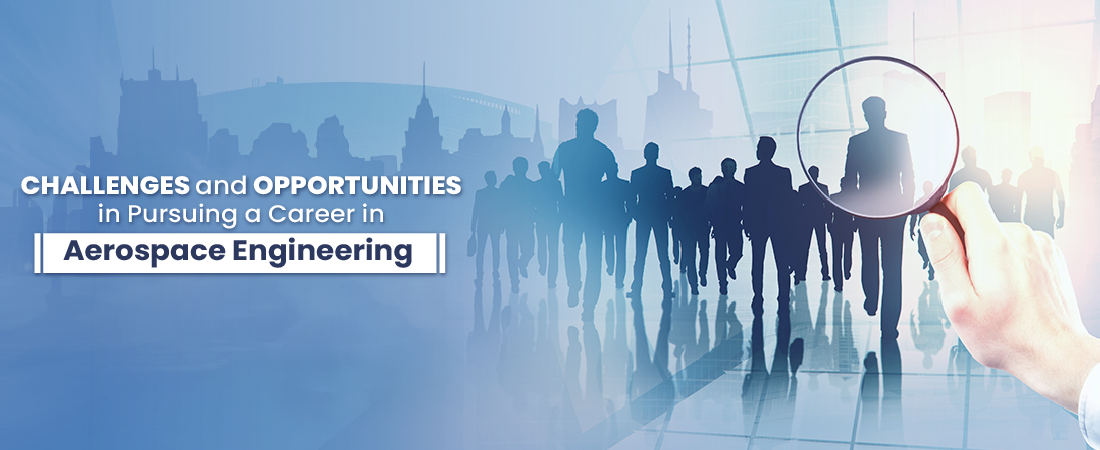
Aerospace engineering is the field of engineering associated with the design and development of aircraft, spacecraft, satellites, unmanned space vehicles and more. This includes industries that design, develop, produce and maintain military and civilian aircraft, spacecraft, missiles, and military systems, collectively referred to as aerospace and defence industries. The defence segment is predominantly with military capabilities and national security while the aerospace segment has both civilian and military uses. Aerospace engineering is colloquially referred to as rocket science which is often the term used to describe anything complex and beyond normal comprehension!
Some of the world’s leading companies in aerospace engineering are Airbus, Boeing, Rolls-Royce, Raytheon, GE Aviation, Safran, Lockheed Martin, etc. According to Zion Market Research, the global aerospace and defence marketplace was valued at around USD 750 billion in 2022 and is estimated to grow to approx. USD 1388 billion by 2030. Worldwide, the leading nations in aerospace are the USA, China, France, Germany, UK and Israel.
According to Modern Manufacturing India, the A&D (Aerospace and Defence) market in India is expected to touch USD 70 billion by 2030. From a single carrier, Air India/ Indian Airlines till the 1990s, India has several civilian airline operators today and this segment is rapidly growing with a large number of airports being established in various cities across India. In the last five years, passenger traffic has grown from 70 million to 200 million in both domestic and international air travel. There is also a demand for smaller aircraft, business aircraft, helicopters etc. for local connectivity.
Traditionally, aerospace in India has been championed by government-owned entities such as HAL, NAL, ISRO, etc. In recent years, large corporate houses like Tata, Mahindra, L&T and Godrej have entered the aerospace industry and are confident of leveraging the expertise acquired in other industry sectors
The Indian Aerospace industry for component manufacture at around USD 250 million, very modest compared with the established economies. This is all set to change in the next 10 years. Considering India’s growing presence in aerospace, several global OEMs and their suppliers are considering it as a destination for the manufacturing of aerospace components and parts, leveraging the low costs and high quality of engineering expertise available. This was experienced with automobile components and experts feel the same could be replicated with aerospace.
Powered by the “Make in India” initiative and the recently initiated National Civil Aviation Policy, many Indian companies are preparing to manufacture aero structures, components, sub-assemblies and complex system assemblies. Leading global OEMs have forged JVs with Indian companies to manufacture parts for commercial and defence aircraft.
The good news is that India is expected to be among the top three markets in the world for civil aviation backed by a tremendous growth in passenger traffic in the past five years, translating to huge orders for commercial aircraft.
This growth would also lead to an increase in MRO and related services which would have potential to create employment opportunities for technicians and engineers. Stand alone, the MRO market for repairs and maintenance services for aircraft is expected to touch USD 4 billion by 2025. There would also be opportunities for leasing, financial, ground support and other allied services with the aerospace sector.
The Indian aeronautics and space segments are evolving though, there have been tremendous achievements in both spaces in recent years. Some of the challengesbeing faced according to defence experts include:
The Indian startup framework for the space industry is just emerging and will need major financial investments as well research on technologies in niche areas like new materials, AI and additive manufacturing.
India is pursuing a vision of becoming the world’s drone hub by 2030 and achieving Atma Nirbharta in key areas in aeronautics and space technology. Public Sector Units have developed technologies such as Light Combat Aircraft (LCA), Advanced Medium Combat Aircraft (AMCA), Advanced Light Helicopter (ALH), Light Utility Helicopter (LUH), Unmanned Aerial System (UAS) and various other exciting technologies.
Indian private sector airlines have created a record of sorts by placing orders for 1000 commercial aircraft at a cost of USD 100 billion in 2023. These along with other global achievements in the space sector from ISRO in the recent months are an indication of the growth the aerospace sector is poised to achieve in the coming years.
School of Engineering under Dayananda Sagar University (DSU), a part of the nationally renowned Dayananda Sagar Group of Institutions, offers a B. Tech engineering program in Aerospace Engineering, a 4 year, full time UG program that trains students in conceptualizing, designing, analysing, developing and producing Mechanical Systems to meet the modern day requirements.
The curriculum developed by the faculty of Department of Aerospace Engineering is outcome based and students develop problem-solving abilities for a smooth transition from academic to a real-life work environment. The course is backed by advanced teaching and learning resources and faculty members have strong connections with the manufacturing sector which makes this programme unique.
Dayananda Sagar University (DSU) has inaugurated a Center of Excellence (COE) in Aerospace Engineering. The primary objective of the COE is to enhance the technical education infrastructure, fostering industry-aligned skill development. This initiative aims to serve as a catalyst for inclusive and sustainable industrial growth and employment opportunities for young individuals.
The COE will feature cutting-edge laboratories covering various aspects such as:
Successful engineers can opt for various aerospace jobs such as Design Engineer, CAE Analyst, Shop Floor Engineer, Production Planning, Quality Assurance, Maintenance Engineer, Safety Engineer, Production Supervisor/Engineer, R&D Trainee, scientists in research labs etc.
Copyright © 2023 DSU. All Rights Reserved